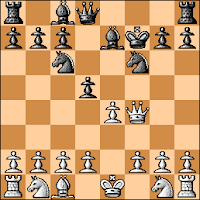
Dear Jerome Gambit Gemeinde,
Another month has passed, this blog has reached 215 consecutive daily posts, and different outrageous lines of play continue to pop up here.
Beside obscure lines in the Giuoco Piano (see "Don't make me go Jerome all over you..."), the Blackburne Shilling Jerome Gambit (see "Blackburne Shilling Jerome Gambit", "Blackburne Shilling Jerome Gambit 2", "Blackburne Shilling Gambit: The Trapper Trapped? (Part I)" and "Blackburne Shilling Gambit: The Trapper Trapped? (Part II)") and the Abrahams Jerome Gambit (see "'Tis A Puzzlement...", "The Abrahams Jerome Gambit (Part I)" and "The Abrahams Jerome Gambit (Part II)") there's even been a couple of Evans Jerome Gambits (see "Evans Jerome Gambit" and "Hoist by my own petard...").
Throughout 2009 I will continue to add games, analysis and history on these lines.
I also got wondering the other day: is there another totally obscure and disreputable tactical opening line or gambit that I could go digging for information about, while I'm researching the Jerome Gambit?? Certainly 1.e4 e5 2.Nf3 d5 and 1.d4 e5 would meet criteria – except the Elephant and Englund Gambits have been lifted out of obscurity by modern analysis and games.
Readers and members of the Jerome Gambit Gemeinde are encouraged to make suggestions in the "comments".
Best wishes,
Rick Kennedy ("perrypawnpusher")
p.s. Visitors to this site have come from 73 different countries, and from 49 of the 50 states & Washington DC.












 7.Qd5+ Kf8 8.Qxc5+ d6 9.Qe3 Be6
7.Qd5+ Kf8 8.Qxc5+ d6 9.Qe3 Be6 
 RevvedUp prefers this quieter move to Hiarc 8's choice in the last game of ...d5 (see "
RevvedUp prefers this quieter move to Hiarc 8's choice in the last game of ...d5 (see " Hiarcs 8 has adopted an interesting positional approach to the position that looks effective for White, even though Black may still retain a bit of his advantage.
Hiarcs 8 has adopted an interesting positional approach to the position that looks effective for White, even though Black may still retain a bit of his advantage. 16...dxe5
16...dxe5 Black's King is in grave danger.
Black's King is in grave danger.









 The rest of the game is not pretty, and in another 10 moves you can start counting the checkmates that I missed, but I'd rather draw the curtain here.
The rest of the game is not pretty, and in another 10 moves you can start counting the checkmates that I missed, but I'd rather draw the curtain here.